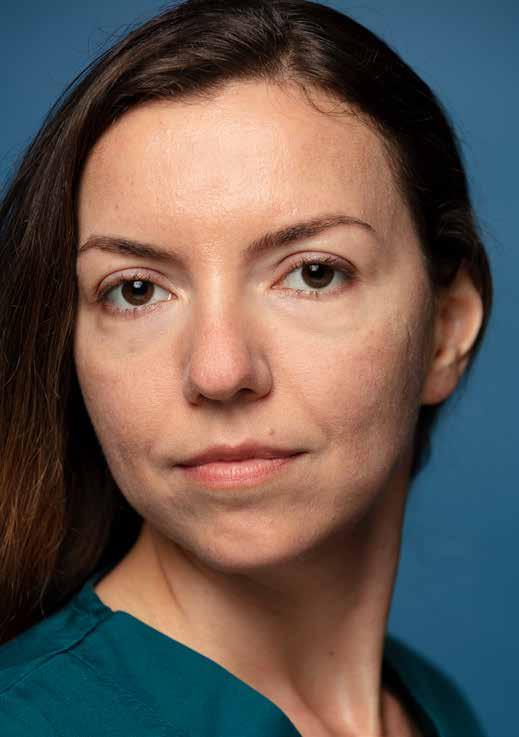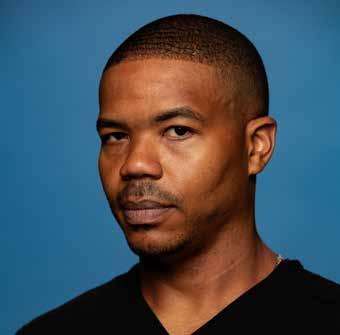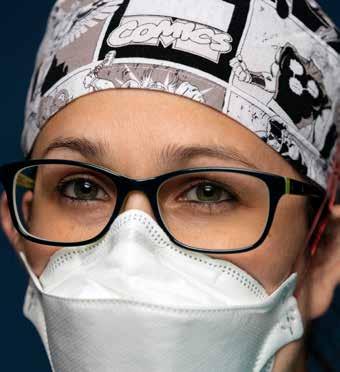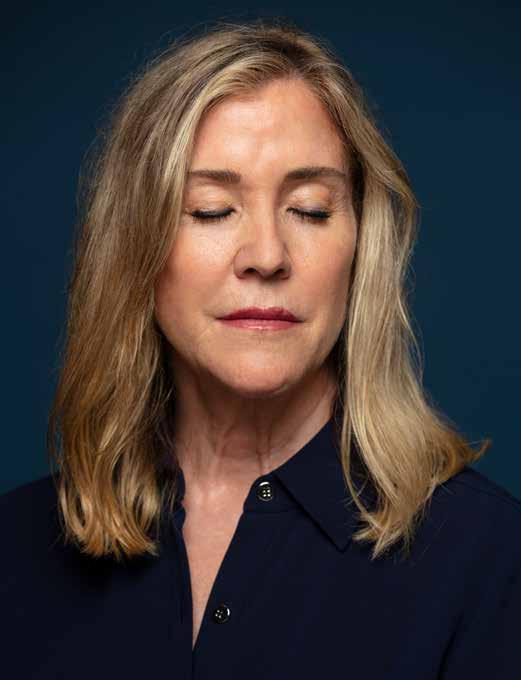
11 minute read
On the Front Lines of COVID-19
Cedars-Sinai healthcare professionals show up every day to fight COVID-19. They quickly yet effectively adapt to ever-changing guidelines about the nature of the disease and its management. As infection rates soar and ebb, clinicians and other team members reconfigure their roles and the hospital’s physical landscape. They seek the best treatments, comfort families—and care for patients, themselves and their colleagues. From the Intensive Care Unit (ICU) to the pharmacy, every Cedars-Sinai employee plays a critical role in a unified force—but their experiences are unique. Here, several share their perspectives from the pandemic front lines.
“I can’t say enough about how heroic our frontline staff has been. We have faced unprecedented challenges with everything from patient care to testing to supply chain management—all evolving very rapidly. In just a few weeks, we produced more than 60 protocols to define safety practices in many areas—from admissions to labor and delivery. I’m really proud of how all this was developed so quickly from scratch in a multidisciplinary way.”
Advertisement
JONATHAN GREIN, MD,
director of Hospital Epidemiology “A lot of this started over Passover and Easter, so we put up signs in ICU windows because we couldn’t go into patient rooms. Some patients saw me with the sign and would smile and give a thumbs up. Afterward, they told us they had no idea even what time of year it was. It reminded us of how painful it is not to be able to do simple things we often take for granted, like gather together as a community.”
RABBI JASON WEINER, PhD,
senior rabbi and director of the Cedars-Sinai Spiritual Care department “Sending a healthy baby and mom home together is the best thing in the world. It’s really a bright spot in all the despair we are confronting with COVID-19.”
KARYN SOLKY, MD,
clinical chief, Department of Obstetrics and Gynecology “There’s a ‘new normal’ every day. In the lab, you need to be clever and you need to think ahead. You figure out what you need and you just make it happen.”
MARGIE MORGAN, PhD,
medical director of Microbiology in the Department of Pathology and Laboratory Medicine
PETER CHEN, MD,
assistant director of the Women’s Guild Lung Institute, and director of the Division of Pulmonary and Critical Care Medicine, who has been treating COVID-19 patients in the ICU
“One of the hardest things is knowing that, when I’m about to intubate a patient and put them on the ventilator, my voice and my words may be the last thing they will ever hear.”
VANESSA BECKETT, MD,
attending physician in the Ruth and Harry Roman Emergency Department (ED) “I got sick after three weeks, and I felt bad for my coworkers because I felt I abandoned them. In these times, we really need each other. I’m back, and we have a lot of personal protective equipment and a lot of support. I tell my patients, ‘You can do this. I was there, and now I’m right here. I know you can do it, too.’ They need to hear that.”
MELANI LIM, RN

ICU Nurse Melanie Lim, RN
MOSHE ARDITI, MD,
director of the Division of Pediatric Infectious Diseases, Allergy and Immunology; director of the Infectious and Immunologic Disorders Translational Research Center in the Department of Pediatrics; and the GUESS?/ Fashion Industries Guild Chair in Community Child Health
“I give one man experiencing homelessness monthly antipsychotic injections. We connected him with Project Roomkey, which provides hotel rooms for people without homes to prevent the spread of COVID-19. When I visited him after his first night in a hotel, he was smiling and had a little bit of bounce in his stride. The apparent gain in health after just one night in a protected space was remarkable.”
COLEY KING, DO,
director of homeless healthcare for Venice Family Clinic, who practices street medicine. [Cedars-Sinai awarded an emergency grant to the clinic to continue outreach during the pandemic.]
“We worked for over 10 days with a patient, and he was just losing the fight. His death was imminent. His son asked me to facilitate a phone call with the family. I geared up in all my protective equipment. He gathered his family and I put a phone on speaker. They were praying for him in Hebrew. They spoke about his strength, and how he gave that strength to them and how important it is. They told him they will carry that forward and always honor that. In these moments, you realize life does cease in a body, but your legacy lives on through other people.”
BARBARA SHEPPARD, RN,
charge nurse for COVID-19 units “Fear results from the perception that we have no control. When we remind ourselves of what we do know, the resources that we have and how our hospital leaders are looking out for us, that builds trust. That fights fear.”
DANIELA TOMUTA, MSN, RN

Nurse Educator Daniela Tomuta, MSN, RN
“Sometimes I enter a patient’s room and they’re intubated, but they’re awake and aware of where they are. I say ‘Good morning.’ Even though they cannot speak, sometimes they answer me with their eyes—or with their hands, by waving. I try to be as friendly as possible because sometimes they’re lonely. Between the nurses and us, we treat them like family.”
ROSA MOLINA,
Environmental Services technician who cleans patient rooms in COVID-19 areas
“Patients feel isolated and fearful, and their families are worried. They’re reading the internet, and there’s so much falsified information out there that doesn’t help with their sanity to get through these hard times. We have to continue battling rumors and be sure they get accurate information. The bond between doctor and patient is so critical, especially now.”
ALOYISUS TSANG, MD,
a primary care physician who has been treating COVID-19 patients in urgent care
ADAM J. MILAM, MD, PhD,

Dr. Adam Milam, chief resident in the Department of Anesthesiology, who co-authored a paper about COVID-19 disparities in Health Equity
“African Americans and Latinos are overrepresented in COVID-19 cases and deaths. It’s devastating but not surprising when people in multigenerational housing are not able to social distance—and they mistrust the healthcare system so they come in too late. Hopefully we’ll use this opportunity to address some of these social determinants of health.”
JENNIFER VAN EYK, PhD,
“The scientific process works, but there’s no magic bullet. The magic is in the innovation and cleverness of top scientists. When you put the number of incredibly creative minds on a problem that we have in the battle against COVID-19, you can move forward faster. That’s what makes me feel optimistic.”
director of the Advanced Clinical Biosystems Institute in the Department of Biomedical Sciences; director of Basic Science Research in the Barbra Streisand Women’s Heart Center at the Smidt Heart Institute; and the Erika J. Glazer Chair in Women’s Heart Health
“We realized that this is probably the biggest challenge we’ve faced in our lifetimes from a medical perspective. We study inflammatory bowel disease, which has a population particularly at risk of COVID-19. Interestingly, a number of the treatments used in inflammatory bowel disease have been suggested as possible treatments for COVID-19, so trying to understand their effect on biology may help in the wider pandemic.”
DERMOT MCGOVERN, MD, PhD,
director of Translational Research in the F. Widjaja Foundation Inflammatory Bowel and Immunobiology Research Institute, and the Joshua L. and Lisa Z. Greer Chair in Inflammatory Bowel Disease Genetics
“I’ve been working at Cedars-Sinai for 32 years. I’m over 65 and my husband is older than I am. Even though I was somewhat afraid in the beginning of the pandemic because of my age, I know that this is where I’m meant to be: supporting my staff and reassuring them that we are safe.”
EVA LUKACS, RDT,
food and nutrition services supervisor, whose unit delivers meals to COVID-19 patients
“The supply chains were sort of strained. Everybody was clamoring for the same medicines—for sedatives, for antivirals—so as those became unavailable, we shifted gears, supplying alternative yet effective medicines. The medical center was pretty nimble in handling the changes. Things that normally take a month to do, we got them done in a day.”
MARK KEEVER, PharmD,
a critical care pharmacist who works in the COVID-19 unit
“Sometimes I am numb to how much important work we’re doing. After recovering from COVID-19 symptoms, I was finally able to give my mom a hug. This virus has caused us all to be apart, and all our efforts are toward bringing us together and making things safe again.”
NIREE HINDOYAN,
clinical research specialist in the Department of Pulmonary and Critical Care Medicine, who coordinated the clinical trial for the experimental drug remdesivir “When pressed by fear in an emergency like this, people may be tempted to cut corners to find effective treatments. We can streamline bureaucracy but we must not compromise the rigor of the scientific methods we use to keep patients safe and decrease any uncertainty about whether a treatment works.”
ANDRÉ ROGATKO, PhD,
director of the Biostatistics and Bioinformatics Research Center
ANGELENA LOPEZ, MD

Angelena Lopez, MD, a Pulmonary and Critical Care Medicine fellow who works with COVID-19 patients in the ICU
“One patient was here about 40 days and I talked to his spouse every other day. Three different times, we had to call her and tell her that her husband wasn’t going to survive the next 24 hours. And then he did. Debriefing after each of those times was so challenging, but she showed such grace in the face of constant uncertainty. After he went home, she wrote me the sweetest card saying she didn’t know what she would have done without me. I don’t know what I would have done without her.”
EMILY MORRIS, LCSW
ICU social worker
“The pandemic has made us keenly aware of how we live in a connected moral community. In the face of these novel hardships as we keep physical distance from one another, it’s increasingly important to remain aware of the significance of social connection and maintain any form of it we can.”
STUART FINDER, PhD, MA,
director of the Center for Healthcare Ethics
“Everything is so time sensitive, and patients can flip on a dime and all of a sudden need to go to the ICU. The faster we can get the drugs to people, the better.”
SUSAN JACKMAN, RN,
supervisor for Research Nursing in the Department of Pulmonary and Critical Care Medicine, who works with patients in clinical trials for COVID-19 “When I read about studies of circulating antibodies, I immediately knew I would be in a position to help. After I recovered, my very next thought was ‘How do I donate blood?’ To know I could potentially have a profound impact on people who are struggling was a no-brainer for me.”
JESSE ERDEK,
who recovered from a mild case of COVID-19 and donated blood for a Cedars-Sinai study into the benefits of convalescent plasma
“I hear a lot of ‘Doc, whatever you’ve got I’m up for it.’ Patients’ confidence in us is a privilege, but that trust can be overwhelming. What we’re studying is a completely novel idea that came from thinking outside the box. We want patients to be involved in the decision and know what they’re getting into.”
SARA GHANDEHARI, MD,
director of Pulmonary Rehabilitation in the Women’s Guild Lung Institute, who leads a clinical trial in the use of the hormone progesterone for men hospitalized with mild to moderate illness from COVID-19
“I had a patient who was on a ventilator but was alert and awake. I tried really hard to communicate with her and got a respiratory therapist to translate. But I wasn’t sure if she could understand. A few days later, she got her tube out and I saw her through the window. She made these heart symbols with her hands and my heart just filled with love. She was one of the success stories.”
SHAWN ESTEBO, RN,
who cares for patients in the ICU
“We’re doing everything we can to understand whether antibodies developed in a person who has recovered from COVID-19 can help another patient fight the infection. Our convalescent plasma study has happened so fast, with researchers and clinicians collaborating to coordinate efforts and the transfusion medicine community nationwide sharing information on weekly conference calls. It’s energizing to be working together to develop this potential therapy.”
ELLEN KLAPPER, MD,
medical director of Transfusion Medicine and co-investigator of the convalescent plasma study
ROSHANAK AAZAMI, PharmD, ED Pharmacist
“For me the crisis has brought to light that we are—without a doubt— stronger when we are together.”
REV. PEGGY KELLEY

Lead Christian Chaplain Rev. Peggy Kelley
“I don’t want to ever forget how precious, tender, beautiful and full of grace and hope this time is. I see beauty in the arc of a patient’s story as I witness resilience and healing. Even in death comes some sort of profound beauty. People are moved and touched and changed. That’s what’s going on right now. People of all faiths are connecting and communicating.”


